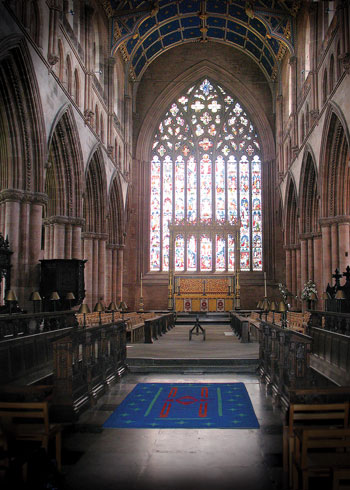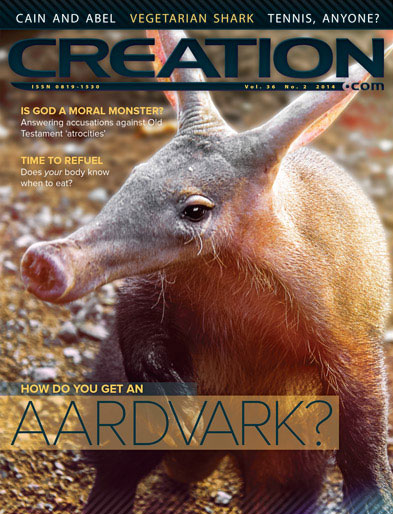Concealed under Carlisle Cathedral’s carpet: dinosaurs!

The curate graciously agreed to roll back the ornate carpet between the choir stalls of the magnificent Carlisle Cathedral in northern England. Underneath was the marble tomb of Bishop Bell who died in 1496, a little over 500 years ago. Surrounding it is one of the best surviving examples of medieval brass work. My wife and I had come to the cathedral to see for ourselves the amazing images engraved in the brass inlay surrounding the tomb which we had read about in Creation magazine.1 The curate explained that the carpet was there to protect the brass work from further wear. This was already quite evident as centuries of choir boys’ feet have shuffled over the tomb.



Why the interest in mediaeval brass etchings? Because among the common everyday animals and plants depicted, there are two strange creatures with long necks and what appear to be bony protrusions on their tails. Today, we would identify such animals as sauropod dinosaurs (see Which dino is that?). But if the evolutionary story of dinosaurs was true, these creatures should have died out millions of years before human beings walked the earth. How could their images be engraved on a 500-year-old tomb in northern England (centuries before studies of dinosaur fossils)?

The curate suggested they were mythical creatures. But why would those craftsmen have depicted a dog (complete with a collar), a fish, a bird, an eel—all common everyday creatures—and then in the midst of them all included mythical creatures? It is far more likely these long necked ‘behemoths’ were in fact known by those artisans and did indeed roam northern England just a few centuries ago. As further confirmation of their authenticity, the creatures have their necks and tails roughly horizontal, which was not how sauropod dinosaurs were depicted in museums for many years. It is only relatively recently that paleontologists have realised that sauropods really did look like this.
The Bible teaches some fascinating things about dinosaurs:
God made both Man and all the land-dwelling animals on Day 6 of Creation Week. (Genesis 1:24–31).
Conclusion: Dinosaurs and man were contemporaries.One pair of every kind of unclean land dwelling animals (and seven pairs of clean animals) came to the Ark. (Genesis 7:2–3,8–9).
Conclusion: Two of every kind of dinosaur went onto the Ark.2Every living thing in which was the breath of life, not on the Ark, perished in the Flood. (Genesis 7:23).
Conclusion: All dinosaurs not on the Ark perished in the Flood.After the Flood, pairs of every kind of creature, including dinosaurs, came off the Ark. (Genesis 8:19).
Conclusion: Two of every kind of dinosaur survived the Flood.
So it is not surprising that history is replete with accounts of people encountering huge beasts, usually referred to as dragons, in the post-Flood centuries.3 Here at Carlisle Cathedral is clear evidence of dinosaurs surviving into the 15th century AD. Such evidence is ‘dynamite’ in our society, since if dinosaurs lived in the not-too-distant past, the evolutionary story must be wrong. But the truth of God’s Word is evident everywhere we look in the world around us, even if we have to look under a carpet to see it!
Which dino is that?
(A Shunosaurus and Vulcanodon on Bishop Bell’s tomb?)
In the book Untold Secrets of Planet Earth: Dire Dragons, with the aid of digitally-enhanced photographs of the Carlisle Cathedral brass engravings, Vance Nelson offers these insights:
“Notice how closely the creature on the right resembles a sauropod dinosaur. Below it is a Vulcanodon for comparison.
“Some people have suggested the creature on the left has a head at the tip of the tail. However, a close examination shows spike-like projections protruding from the tip of the tail. It is likely that this is another type of sauropod resembling the Shunosaurus. To date, Shunosaurus [fossils] have only been found in China.
“If the tail of the creature on the left was straightened, we would notice four tail spikes: two pointing up and two pointing backwards. What some may perceive as an eye is probably just an imperfection in the brass as seen in other areas. What some suggested as an inaccuracy has actually become further evidence from the same carving that people must have seen living dinosaurs.”

References and notes
- Bell, P., Bishop Bell’s brass behemoths! Creation 25(4):40–44 2003, creation.com/bb. Return to text.
- Note that there were far fewer kinds than named ‘species’, and they were also probably taken on board as juveniles, before their massive growth spurt. See Sarfati, J., How did dinosaurs grow so big? And how did Noah fit them on the Ark? Creation 28(1):44–47, 2005; creation.com/dinogrowth. Return to text.
- For more, see: creation.com/coexist. Return to text.






Readers’ comments
Comments are automatically closed 14 days after publication.